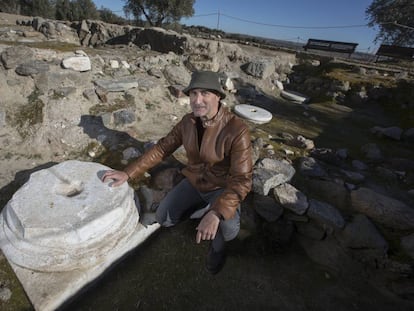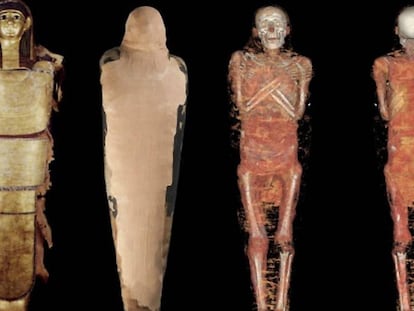The first ¡®skyscraper¡¯ of the Middle Ages was in Toledo
Spanish, English and German archeologists are studying a 12-meter high Visigothic palace built at the start of the 6th century

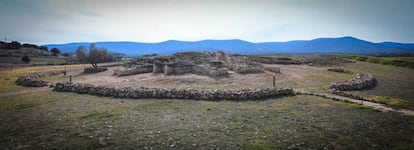
On account of the bears, wild boar and other animals lurking in the forests that stretched some 30 kilometers around Toledo, the capital of the Visigothic Kingdom, the chief of the province ¨C or Dux ¨C decided to build a grand two-story building for hunting purposes at the start of the 6th century.
One hundred years later, a church, a warehouse and a dike to contain the water from the mountains were built beside the castle-like structure and enclosed by a wall more than two meters thick. Many years later this area, which covered five hectares, would become the hamlet of Arisgotas, within the municipal boundaries of Orgaz, in Toledo province.
A team of more than 100 experts from several universities led by Isabel Mar¨ªa S¨¢nchez Ramos, from the Institute of Archeology of University College London, have spent the last three years reconstructing this enigmatic enclave. At Los Hitos archeological site, researchers have dug up more than 100 bodies, including that of the Dux, and estimated that the height of the tallest building was over 12 meters. It was not until the ninth century that this record was trumped by the 20-meter-high minaret in C¨®rdoba, designed by Moorish architects.
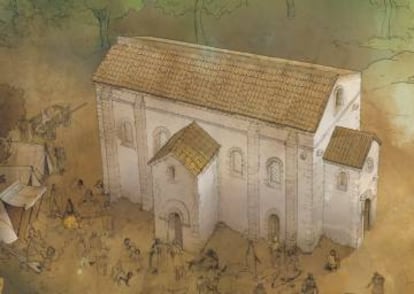
Much later, in the 16th century, the local peasants in Arisgotas kept coming across massive stones as they worked the land ¨C the stones, or hitos, that would give the place its name. These blocks were typically? taken into town and used in the construction of the houses there. In the first decade of the 20th century, a local known as ¡°T¨ªo Sim¨®n¡± discovered an alabaster tomb and, in 1938, the government of the Spanish Republic sent a team of experts to investigate.
But it wasn¡¯t until the 1970s that archeologists began to excavate and, with their findings, developed the theory that the tall building had been a church surrounded by stone coffins and tombs.
In 2016, fresh excavations began, allowing experts to establish that the unusually high building had, in fact, been a palace of a member of the nobility of Toledo. Jorge Mor¨ªn, director of the dig, explains that the building¡¯s height was calculated using Pythagoras¡¯s technique for doubling the area of a square, and at over 12 meters it was the first ¡°skyscraper¡± of the Early Middle Ages. ¡°It took centuries to go higher,¡± he says. ¡°There is indisputable evidence of abutments used to increase the wall height with views to the vault and to an upper floor, also confirmed by evidence of a staircase by which the upper floor would have been accessed.¡±
The Dux¡¯s tomb was found in the building¡¯s doorway and his bones indicate he was a man who spent much of his time on horseback. His burial place is surrounded by the tombs of other notable figures and their families, including women. At the foot of the door to the church, the skeletons of nine children have been found, buried along with small pots that would serve to feed them in the afterlife.
Other remains have still to be analyzed but could belong to monks. A massive tombstone has also been unearthed, belonging to either a king or a Dux whose name ends in the letters ¡°-do.¡±
Experts estimate that another 10 years are needed to unearth all the mysteries buried beneath
It has not yet been established whose body was excavated from the main tomb, only that he was a nobleman and that, given the system of choosing Visigothic Kings, he could have been in the running for the crown. But for now at least this is no more than speculation. What does seem clear is that the complex was built during the reign of Athanagild and Goiswintha (551-567) and was expanded during the reign of Reccared I (586-601)
In 2017, the archeologists found a temple adjacent to the castle-like structure with only one nave and two porticos. Its interior was decorated in marble and it housed a number of coffins fashioned in alabaster and granite. According to specialists, this could have been a private place used only by the nobility, complete with family vaults.
Antonio Malalana, director of research methodology at CEU-San Pablo University, explains that at the next stage of the dig, bodies will be unearthed in a more protected environment to avoid contaminating the DNA. ¡°It¡¯s very complicated work which obliges those involved to be properly equipped and covered,¡± he says.
Work being carried out under the watchful eye of Felix Teichner from Marburg University in Germany has just revealed a further four underground structures, around 20 meters long and 10 meters wide.
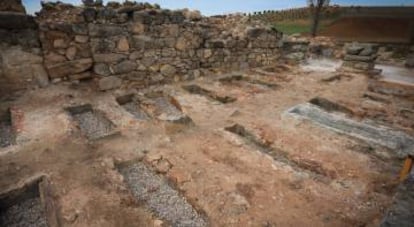
In the ninth century, during the Al-Andalus period, the complex was subject to great changes. The church, for example, was shifted to face Mecca and turned into a mosque with a mihrab ¨C a semi-circular niche in the wall indicating the direction the faithful should pray in. Stairs were added to the pavilion while doors were walled up. The complex was used as a fortified space for harnesses and tack for horses. With King Alfonso VI¡¯s conquest of Toledo in 1085, it fell into ruin and became a quarry for the locals.
Now, experts estimate that another 10 years will be required to unearth all the mysteries buried beneath.
English version by Heather Galloway.
The small but spectacular local museum
In 2018 the mayor of Orgaz, Tom¨¢s Villarubia of the Socialist Party (PSOE), gave the researchers funds to turn a former school in the area into a museum. Inside are more than one hundred artifacts from the excavation, many of which have been donated by locals who also helped to reform the school at low cost.
¡°At first some people asked for money for their artifacts, but they soon realized that their donations were good for the town and gradually they brought what they had,¡± says Juana Mart¨ªn, the mayor of the hamlet of Arisgotas.
And each piece now bears the name of the donor. ¡°There were people who brought several pieces and they would say, ¡®Put this in the name of my son and this in the name of my daughter and name this one after my wife¡¡¯¡± she explains with a chuckle.
Then there are the stones from the complex that form part of the town itself, being built into the walls of the buildings that house its 30 inhabitants. The council has now put up plaques so that visitors can look around the streets in search of these stones that were once a part of an important enclave in the Middle Ages.
Tu suscripci¨®n se est¨¢ usando en otro dispositivo
?Quieres a?adir otro usuario a tu suscripci¨®n?
Si contin¨²as leyendo en este dispositivo, no se podr¨¢ leer en el otro.
FlechaTu suscripci¨®n se est¨¢ usando en otro dispositivo y solo puedes acceder a EL PA?S desde un dispositivo a la vez.
Si quieres compartir tu cuenta, cambia tu suscripci¨®n a la modalidad Premium, as¨ª podr¨¢s a?adir otro usuario. Cada uno acceder¨¢ con su propia cuenta de email, lo que os permitir¨¢ personalizar vuestra experiencia en EL PA?S.
En el caso de no saber qui¨¦n est¨¢ usando tu cuenta, te recomendamos cambiar tu contrase?a aqu¨ª.
Si decides continuar compartiendo tu cuenta, este mensaje se mostrar¨¢ en tu dispositivo y en el de la otra persona que est¨¢ usando tu cuenta de forma indefinida, afectando a tu experiencia de lectura. Puedes consultar aqu¨ª los t¨¦rminos y condiciones de la suscripci¨®n digital.
